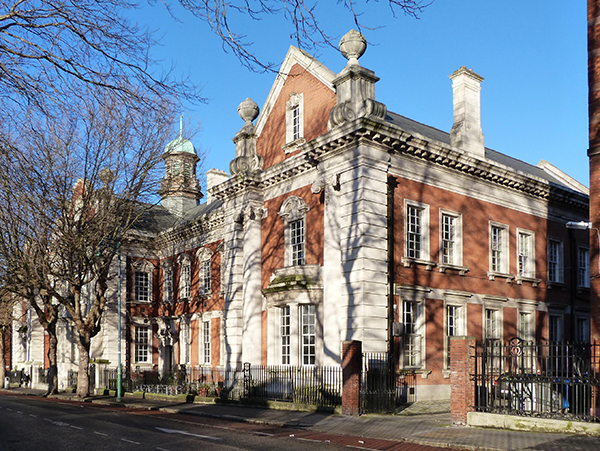Iveagh Play Centre
Published in Gems of Architecture, Issue 4 (July/August 2017), Volume 25Bull Alley Street, Dublin 8
By Niamh Marnham
The Iveagh Play Centre (1912–15), Bull Alley Street, Dublin, was an innovative school intended to complete the philanthropic vision of Edward Cecil Guinness (1847–1927), first earl of Iveagh. It, and the larger scheme of which it was part, provides a notable example of the power and reach of private philanthropy in poverty-riven late Victorian and early Edwardian Dublin.
Iveagh created a complex of housing, educational and health-improving facilities to replace tenement slums around St Patrick’s Cathedral. Known collectively as the ‘Bull Alley Complex’, it consisted of workmen’s housing, the workmen’s hostel Iveagh House, and the Iveagh Trust Public Baths. The Iveagh Markets were also intended as an integral part of the enclave. The last piece put in place was the Iveagh Play Centre: the aim was ‘to provide education with amusement, so that the two wants of children can be catered for’.
A site facing St Patrick’s Cathedral was selected and a limited architectural competition was held. The design chosen, by the Dublin firm McDonnell and Reid, has been described as ‘the most ambitious school building in the city … an exuberant and generously scaled essay in a Free Queen Anne idiom’. Laurence Aloysius McDonnell (1867/8–1925) had already enjoyed the patronage of the seventh earl of Aberdeen, lord lieutenant of Ireland, and his philanthropist wife, while together with Alexander William Douglas Reid he had recently completed the construction of Lord Iveagh’s son’s house, Glenmaroon, in Chapelizod.
Work began in October 1911 and the play centre, for children aged 3–14 living in the Patrick Street and Bride Street flats, opened in May 1915. The building was erected by McLaughlin and Harvey, Belfast, and cost £40,000.

Above: Fronting onto St Patrick’s Park, the Iveagh Play Centre is a grandiose edifice resembling a stately country house overlooking a formal garden. (NIAH)
Prominently fronting onto St Patrick’s Park (1901), the Iveagh Play Centre is a grandiose edifice resembling a stately country house overlooking a formal garden. Faced with vibrant Kingscourt red brick, the contrasting ‘white’ limestone dressings produce an eye-catching two-tone palette in contrast to sober St Patrick’s Cathedral. The centre-piece, a cupola-topped projecting breakfront, features a curvilinear gable, which can be interpreted as a nod to the ‘Dutch Billys’ once lining Dublin’s streets. Boldly modelled door-cases decorated with acanthus-detailed pulvinated friezes, scroll pediments, garlands and swags lead to the vestibules and classrooms. The Bull Alley Street front finishes in projecting ‘pavilions’ with Ionic pillars framing colonnaded polygonal bay windows. A beautifully carved modillioned cornice stretches across the façade, supporting scroll-footed ball finials on the corners of each projection. The conventional finish and historical architectural references mask an innovative framework, as the English Expanded Metal Company supplied metal for the fire-resistant reinforced concrete construction.
With bright, airy classrooms, the play centre also boasted an assembly hall-cum-concert hall and a gymnasium. It was open five evenings and one morning a week, and boys and girls learned subjects such as basket-weaving, dancing, gymnastics, needlework, painting and singing. The centre quickly earned the affections of the local children, who nicknamed it the ‘Bayno’ (beano or ‘free-for-all’) for the superior quality of its free buns and cocoa. Yet it was not just buns and cocoa that endeared the school to the children, and from the outset it was successful as a venue for practical education and social interaction. The Iveagh Play Centre closed in 1975; as the home of Liberties College, however, the tradition of education and entertainment continues for post-Leaving Certificate students.
Niamh Marnham is a Senior Built Heritage Consultant at Ove Arup & Partners. She is the author of the upcoming NIAH publication An introduction to the architectural heritage of Dublin South City (2017). Series based on the NIAH’s ‘building of the month’, www.buildingsofireland.com.


















